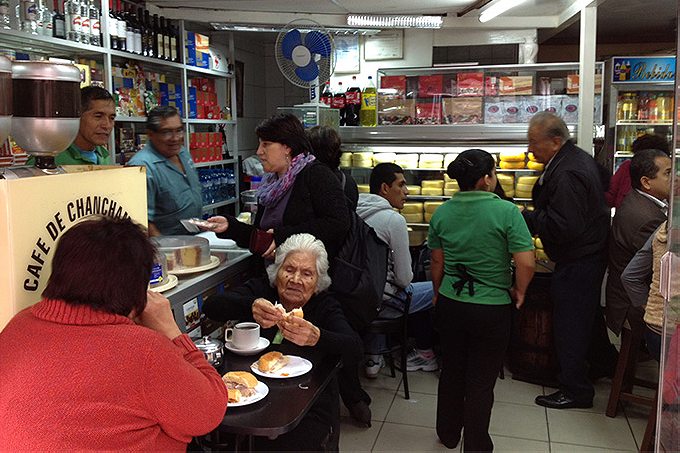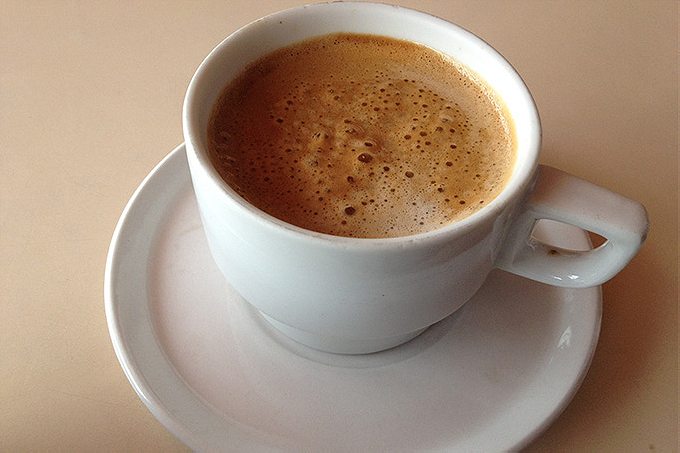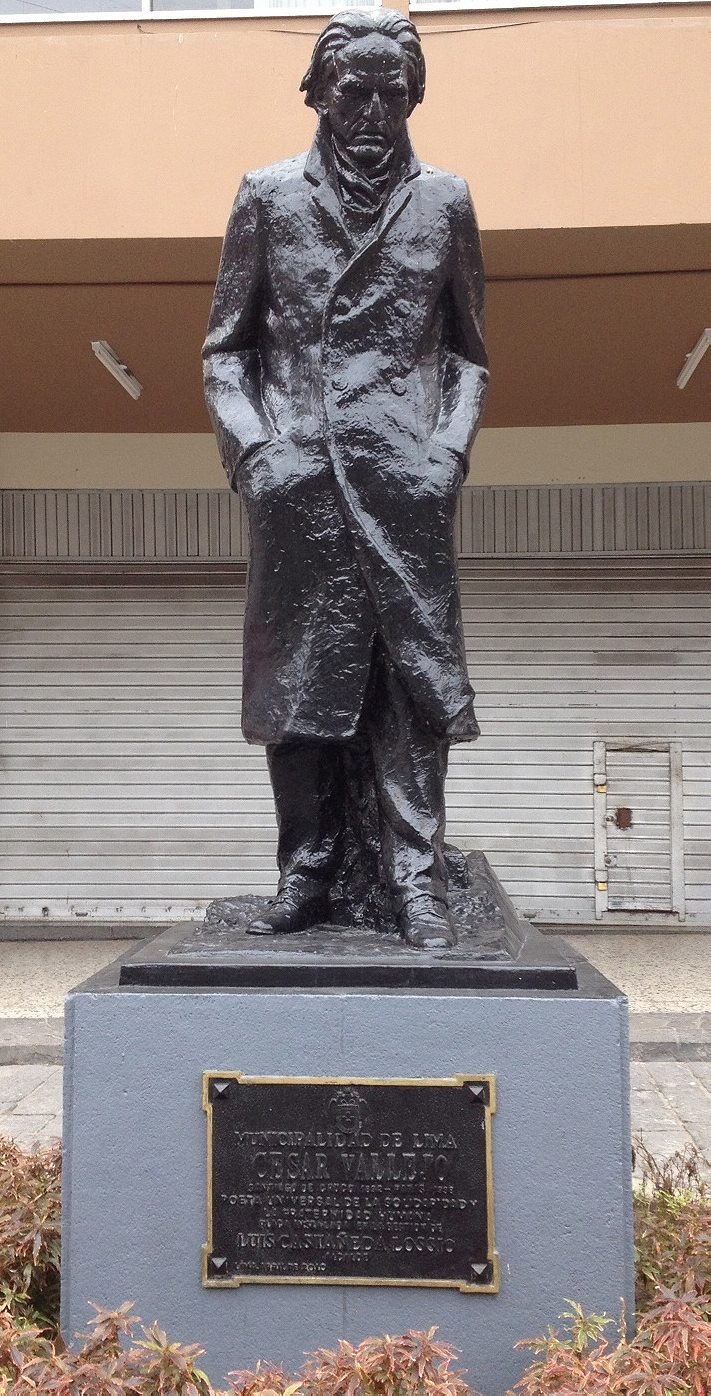Searching for the ghost of legendary Peruvian poet Cesar Vallejo in the cafés of Lima.
At a café in the opulent Lima neighborhood of Miraflores, a bow-tied waiter ceremoniously poured cream over my espresso. Outdoor wicker chairs enveloped patrons in a Parisian bubble. On the sidewalk, a busker huffed morose ballads into his pan flute, dressed in a jacket worthy of Elvis. A cafe patron in gray-and-baby-blue tweed rested his eyes, and a peddler woke him by asking him to buy a newspaper.
Indignant, he told the salesman, “It’s not even today’s paper!”
Café Haiti has entertained intellectuals and Miraflores sophisticates since 1962. I was searching for the type of café legendary Peruvian poet Cesar Vallejo would frequent if his timeline had overlapped with mine. Café Haiti fit the bill with its French aspirations and heady conversations.
My café con leche (7.5 soles/$2.68) was strong. Tiny bubbles skimmed the top, confirming the fine quality of the espresso. I drizzled chunky sugar into the swirling drink, and the creamy caffeine warmed my mouth with hints of citrus. Meanwhile, a toothless woman approached two wizened men at the cafe.
“What lovely men” she said.
A policeman shooed her away. The busker was formally asking for money and allowed to stay, but the pucker-mouthed woman eventually hobbled off. I thought about how she might need soles more than the musician, but decided not to abandon my drink because, ridiculously, I was embarrassed to break the order the policeman had imposed.
Vallejo himself had a conflicted relationship with coffee and the needy. His poem “El Pan Nuestro,” or “Our Daily Bread,” gives a summary of his feelings: “I came to get something for myself that maybe/ was meant for another man;/ and I think that, if I hadn’t been born,/ some other poor man might have drunk this coffee/ I’m a filthy thief . . . Where am I headed!” A spokesman for indigenous Peruvians, Vallejo had grown up in a desolate town in northern Peru. His move to Lima introduced him to Bohemian ideals, sophisticated scholars, and the divide between wealthy businessmen and the campesinos of his youth.

As it is with coffee, so it is with travel. I hopped from café to sandwichería, scouring Lima for Vallejo’s coffee, and averting my eyes from the limeños who couldn’t afford the espresso drink in front of me, much less the international ticket it took to get me here. Travelers to developing countries often confront the guilt Cesar Vallejo writes about — the feeling of taking someone else’s place. We try to justify our presence by volunteering, tipping heavily, or simply blogging to share our discoveries. None of it completely erases our shame.
COFFEE IS A LUXURY GOOD FOR PERUVIANS, EVEN THOUGH THEIR COUNTRY IS THE FIFTH LARGEST PRODUCER OF ARABICA BEANS
Even when we come home, travelers affect the food supply for the world’s poor. We return with broadened tastes that influence our aunts and co-workers, and shift the marketplace for certain foods. For example, quinoa, a formerly obscure South American grain, has become trendy in Western markets because of its high-protein content. Since 2006, its prices have tripled, and in Lima quinoa now costs more than chicken, according to The Guardian. Many Bolivian and Peruvian farmers who used to survive on quinoa can no longer afford their dietary staple.
Coffee is also a luxury good for Peruvians, even though their country is the fifth largest producer of Arabica beans. In Lima, a cup ranges between 2 and 8 soles—from 70 cents to nearly $3 in more touristy areas. Most Peruvians drink Nescafe instead. A jar costs less than 10 cents per cup. In many Peruvian pueblos, instant is the only form of coffee available from restaurants and stores. Roasters are prohibitively expensive. Despite growing some of the finest coffee in the world, Peruvians rarely enjoy the real stuff because they can’t compete with prices offered by North American and Western European markets. From Kenya to El Salvador, this sad reality plays out through most of the coffee-growing world.

Meanwhile, the U.S. is the largest importer of coffee, according to the International Coffee Organization. American workers have the kind of disposable income to spend $1,000 on coffee a year. Our respective earnings put this in perspective: In 2010, the average Peruvian income was $5,026, while the average U.S. income was $47,153. Peru is also plagued by stark inequality; indigenous Peruvians make half the average income of the non-indigenous.
DESPITE HIS GUILT, VALLEJO DRANK COFFEE IN THE TONIEST OF JOINTS, THE PALAIS CONCERT
Despite his guilt, Vallejo drank coffee in the toniest of joints, the Palais Concert. On Lima’s dusty tiled walkway Jiron de la Union, built by Francisco Pizarro himself, lies the grand edifice where poet Cesar Vallejo sipped espresso. Today, its mahogany doors are shuttered. Owned by the department store Ripley and undergoing renovations, it faces a KFC. But the Parisian-inspired ornamentations surrounding each window — beige heads framed by fruit clusters — serve as a reminder of the bacchanalian and intellectual revelry that once happened in the Palais Concert starting in 1913.
Cesar Vallejo caroused there with writers of the Colónida movement, which rebelled against the colonialism in Peruvian literature by incorporating French and Italian influences, as well as marginalized voices. They considered the Palais Concert the movement’s headquarters, with its floral style modeled after France’s Café de la Paix and its “tasty smell of chocolate, vanilla, ginger, cinnamon, coffee and gin,” wrote lawyer Luis Alberto Sánchez. Vallejo’s drinking buddy, Colónida writer Abraham Valdelomar, said: “Peru is Lima, Lima is the Jiron de la Union, the Jiron de la Union is the Palais Concert, and the Palais Concert is me.”
A century later, I gawked up at the Palais Concert, admiring its sinewy wrought iron details, when students from the Instituto Charles Chaplin, a media school, ambushed me for an interview.
“What would you do if a man said dirty things to you on the street?” they asked me in front of their loaned video camera.
“I would tell him to grow a pair of cojones,” I said.
After the interview, the students confirmed that the building behind us was, in fact, the legendary Palais Concert. They asked other interviewees to double-check.
I walked on for another cup of coffee at Café Bodega Santa Isabel, a block away from Palais Concert — and two blocks away from a statue of Cesar Vallejo. His bronze face scowls at the ground. In 2011, a group of activists put up a cardboard sign beneath the statue with a quote from the poet: “Hay, hermanos, muchísimo que hacer” (“There is, brothers, still so much to do”).

Beneath a nameless awning, Café Bodega Santa Isabel was crammed with downtown lunch-goers, and those waiting for tables hovered above the seat of their fancy. Almost everyone munched on meat-and-onion sandwiches with a side of coffee for 12 soles total, less than $5. I was eventually placed at a table bordering the sidewalk. As I looked around, a stray coffee bean from the grinder pelted my arm.
I washed down my turkey sandwich with black coffee. The beans came from the Chanchamayo province, an area renowned for its high-altitude coffee. The soft baguette, flakey on the outside, gooey on the inside, was dusted with flour. Sweet slices of meat complemented the nutty, robust drink, which I took with a pinch of sugar and no milk, as I imagined Cesar Vallejo might. He also taught Spanish grammar less than a mile away at Colegio Nuestra Señora de Guadalupe.
As I finished my last bites, another patron sat down at my table. She introduced herself as Alejandra, and ordered a coffee and no sandwich — she had brought her own homemade cheese tamale in a plastic bag. Two women paying for their lunch couldn’t stop staring at her meal. They asked where she bought the tamale. Alejandra ran a criollo restaurant out of her home de vez en cuando (“from time to time”), she told them. She had gold cap on her bottom teeth and wavy copper hair, and she indulged my every question. In her fifties, Alejandra was retired. She had owned a restaurant before but downsized into her own home.
WHEN BUYING COFFEE, A CUSTOMER CAN OFFER TO RESERVE AN EXTRA CUP FOR AN ANONYMOUS GRANTEE
An idea entered my head from a story I’d read about Café Pendiente, an Argentine organization that encourages consumers to buy coffee for the less fortunate. When buying coffee, a customer can offer to reserve an extra cup for an anonymous grantee. Poor Argentines then stop by to see if any “café pendientes” are still available.
As I paid for my 12-sole meal, I asked the cashier how much Alejandra’s coffee was. “Dos soles cincuenta.” I gave him 14.5 soles, and asked to cover Alejandra’s tab. I tried to leave before she knew.
After the waiter told her, she said “Gracias! Gracias!” I rushed out of the restaurant and heard her ask in disbelief, “For me?”
The words of Cesar Vallejo repeated in my head: “There is, brothers, still so much to do.”